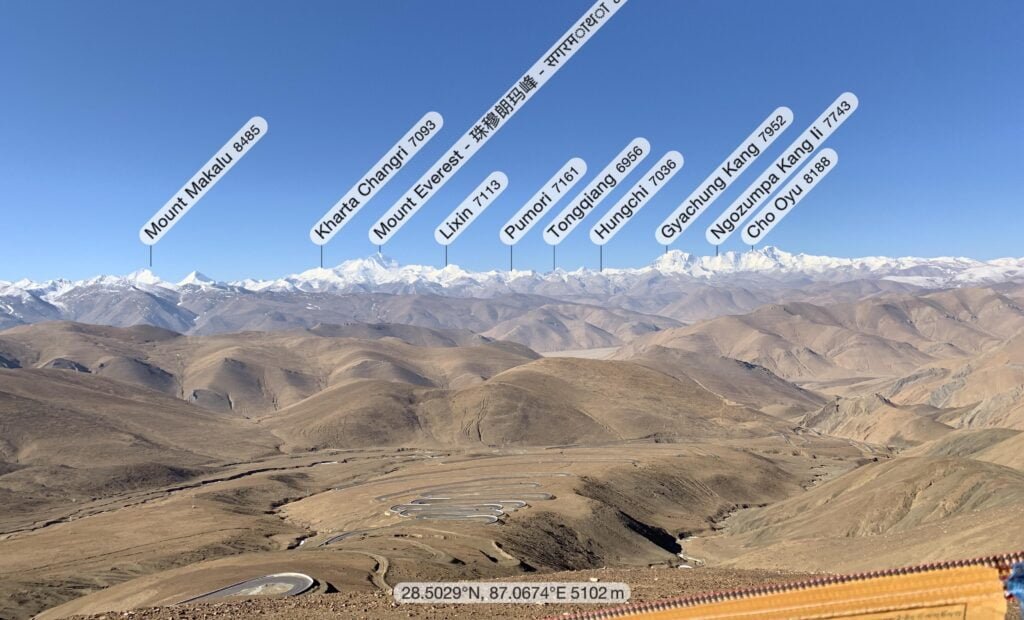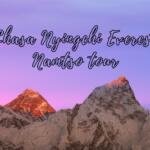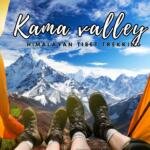Embark on an unforgettable 11-day journey through Tibet, exploring some of its most sacred and stunning destinations. This adventure begins in the cultural epicentre of Lhasa, then winds through the picturesque Nyinchi, the historic Shigatse, and culminates at the iconic Everest Base Camp. Each stop on this journey offers a unique window into the rich tapestry of Tibet’s history and the breathtaking beauty of its natural landscapes.
Tibet’s Timeless Trail: 11 Days from Nyinchi’s Green Valleys to Everest’s Grandeur
Best Time to Visit:
- April to June and September to October: These months are ideal for visiting Tibet. You’ll experience pleasant weather, clear skies, and fewer tourists. These conditions are perfect for exploring outdoor sites and engaging in cultural activities.
- July and August: While these months mark the peak tourism season in Tibet, they also bring larger crowds and busier attractions. However, the landscape is vibrantly green and the weather is warm, making it a great time for those who don’t mind the extra company.
Recommended for:
- This tour is a fantastic choice for anyone who appreciates nature, culture, and adventure. Whether you’re a solo traveller, part of a group, or with family, this journey through Tibet promises to be enriching and exhilarating.
As you traverse through the serene monasteries, lush forests, majestic mountains, and remote villages, you’ll gain an intimate understanding of Tibetan culture and the natural splendour that defines this region. This trip is more than just a vacation; it’s an exploration of some of the most spiritually significant and naturally stunning places on Earth.
Day 1: Arrival in Lhasa
Upon landing in Lhasa, you’ll be greeted and escorted to your hotel. As you travel, marvel at the stunning landscapes along the Yarlung Tsangpo River. Once at the hotel, take this day at leisure to explore the city and adjust to the high altitude.
Lhasa’s Altitude Acclimatization Tips:
- Limit Physical Activity: Avoid strenuous activities to reduce the risk of altitude sickness.
- Showering: It’s recommended to skip showering on the first day to prevent colds due to the sudden temperature change.
- Alcohol Consumption: Avoid drinking alcohol as it can exacerbate altitude sickness.
- Hydration: Drink plenty of water to stay hydrated.
- Diet: Eat fruits in moderation and opt for light meals.
- Medication: Consider bringing Diamox or traditional Tibetan medicines like Rhodiola rosea or Gaoyuanan for altitude sickness.
- Rest: Ensure regular rest and limit your outings for the first few days.
Enjoy the mysterious charm of Lhasa and start your journey into the wonders of Tibet! Remember to take care of your health as you adjust to the high altitude and prepare for the amazing experiences ahead.
Day 2: Lhasa to Nyingchi via Kadinggou:
- Drive on the Lhasa Nyingchi Expressway: Your journey begins on National Highway 318, also known as the Lhasa Nyingchi Expressway. This route, part of the Sichuan-Tibet and Yunnan-Tibet Highways, is famed for its stunning views.
- Beside the Niyang River: Travel south alongside the enchanting Niyang River, a constant companion on your journey to Nyingchi. The river’s serene flow adds to the tranquillity of the drive.
- Kadinggou – A Natural Paradise: Your route takes you through Kadinggou, often described as a paradise. This gorge offers a profound experience with its narrow canyons, gentle water sounds, and the sensation of walking through untouched woodlands.
- Landscapes to Remember: The drive is characterized by towering mountains, deep ravines, unique rock formations, and ancient forests. You’ll also find bamboo forests, adding to the diversity of the terrain.
- Photographic Opportunities: The snow-covered plateau, dotted with snow-capped mountains, dense forests, and sprawling grasslands, provides ample opportunities for photography. Capture the essence of Tibet’s natural beauty as you travel.
Day 3: Nyingchi to Sejila Pass to Lulang Forest to Basum Tso
- Sejila Mountain: Begin your day with a visit to Sejila Mountain, part of the Nyachen Thanglha range. Standing at 4728 meters above sea level, this mountain offers breathtaking views of an ocean of clouds and dense forests. On a clear day, you might even catch a glimpse of Namchak Barwa, known as “China’s most beautiful mountain,” towering at 7782 meters.
- Lulang Forest: Next, explore the Lulang Forest, a place of natural beauty and serenity. This forest is known for its cloud-covered mountains and misty vistas that are so beautiful they often evoke feelings of homesickness in visitors. The region is surrounded by snow-capped mountains and lush valleys, with forests that appear artfully pruned and meadows that add to the picturesque scenery.
- Basum Tso: The day’s journey culminates at Basum Tso, a stunning lake that adds to the tranquillity of the region. The lake, flanked by forests and mountains, provides a peaceful retreat and a perfect opportunity for contemplation and photography.
This day of your journey through Tibet immerses you in landscapes that seem almost otherworldly in their beauty. Each destination offers a unique perspective on Tibet’s natural splendor, from high mountain vistas to misty forested valleys and serene lakes.
Day 4: Basum Tso to Jieba Village to Lhasa
- Basum Tso Exploration: Begin your day at the exquisite Basum Tso, a region renowned for its stunning landscapes. Surrounded by mountains, lakes, dense woodlands, cascading waterfalls, and lush meadows, Basum Tso is a 5A-level Forest Park offering a one-hour tour filled with natural beauty and tranquillity.
- Island and Attractions: In the heart of Basum Tso, visit the unique island featuring several attractions. You can see a special pine tree adorned with peaches, explore the water burial platform, marvel at the “alphabet tree” inscribed with Tibetan characters, and discover a holy spring. The island also provides spectacular views of the surrounding mountains and lakes, along with the ancient Tsozong Gompa, a symbol of Tibetan religion.
- Jieba Village: The next stop is Jieba Village, known for its breathtaking views of Basum Tso and the nearby mountains, including the “King’s Throne” and “Burning Flame” peaks. The village, set in an untouched region, showcases the serene beauty of Tibet with its crystal-clear river, meadows frequented by grazing animals, and an overall magical ambience.
- Return to Lhasa: After soaking in the natural and cultural wonders of Basum Tso and Jieba Village, you’ll make your way back to Lhasa. This journey offers a moment to reflect on the diverse experiences of your trip so far, from the spiritual depths of monasteries to the untouched natural beauty of Tibet’s landscapes.
Day 5: Lhasa City Tour – Jokhang Temple and Sera Monastery
- Jokhang Temple Visit: Explore the Jokhang Temple, a pivotal site in Tibetan Buddhism. This temple is a stunning amalgamation of architectural styles from Tibet, the Tang Dynasty, Nepal, and India. As you approach, you’ll notice the profound impact of devout worship, evident in the deep imprints left by prostrations on the bluestone floor at the entrance.
- Be aware that the temple may occasionally close for religious activities or events.
- Barkhor Street Exploration: After your temple visit, enjoy some free time wandering Barkhor Street. This area is known for its traditional prayer-turning ritual, offering a glimpse into the daily religious practices of Tibetans.
- Sera Monastery Experience: Your next stop is the Sera Monastery, one of the most important monasteries of the Gelug Sect in Tibetan Buddhism. The monastery is home to numerous Vajra Buddha statues, including the famous “Hayagriva” Vajra statue.
- Debating Sessions: Sera Monastery is particularly famous for its debating sessions. These intellectual discussions, led by lamas, involve a unique method of debate using applause and prayer beads to make points. These debates, starting at 15:00, are a vibrant display of Tibetan Buddhist practice and scholarship. Note that sessions may be subject to cancellation due to special events.
Day 6: Lhasa City Tour – Potala Palace and Tibetan Cultural Experience
- Potala Palace Visit: Discover the magnificent Potala Palace, a symbol of Tibetan history and culture. Built by Songtsan Gampo, it’s renowned for its intricate architecture, dimly lit halls, draped windows, and the unique aroma of butter lamps. Inside, explore the myriad of scriptures and statues that have captivated visitors for centuries.
- Tibetan Cultural Experience: Spend the rest of your day immersed in Tibetan culture. This may include visiting local markets, engaging with artisans, participating in cultural workshops, or attending traditional music and dance performances. It’s a chance to delve deeper into the rich traditions and lifestyle of the Tibetan people.
Day 7: Lhasa to Yamdrok Yongtso, Karola Glacier, and Shigatse
- Yarlung Zangbo River Valley: Start your day with a scenic drive through the Yarlung Zangbo River Valley. You’ll have the opportunity to observe this magnificent river from an aerial viewpoint along Highway 101, and then again from Highway 307. The panoramic views of the widest river in the Lhasa area are truly awe-inspiring.
- Yamdrok Yongtso Lake: Your journey continues to Mount Gambala, where you’ll witness the stunning Yamdrok Lake, often described as “angel tears in the sky.” This turquoise blue lake is surrounded by snow-capped mountains and vibrant landscapes, offering breathtaking views and photo opportunities with yaks on Gambala Mountain. Remember to negotiate prices for yak pictures in advance.
- Karola Glacier: Visit the Karola Glacier, one of Tibet’s three major continental glaciers, located near Nochin Kangsang Snow Mountain. Despite its gradual retreat, the glacier’s upper half shines brilliantly in the sunlight, resembling a giant thangka. This natural wonder is not only a beautiful sight but also a reminder of the changing environment.
- Arrival in Shigatse: Conclude your day in Shigatse, Tibet’s second-largest city with a rich history spanning 500 years. Known as “the best estate” in Tibetan, Shigatse is a significant center for politics, religion, and culture, and was historically the headquarters of the Panchen Lamas.
Helpful Reminder for Travelers:
- Travel Permit for Mount Everest: If your journey includes a visit to Mount Everest, remember that foreign tourists need an additional travel permit, obtainable in Shigatse. Stay flexible as your tour guide may adjust the itinerary based on the permit’s status. Cooperate with your guide’s arrangements and be prepared for possible delays in permit processing, especially during peak seasons.
This day offers a unique blend of natural wonders and cultural insights, as you travel through some of Tibet’s most stunning landscapes and end in a city rich in Tibetan heritage. Enjoy the journey and the diverse experiences it brings.
Day 8: Shigatse to Gyawula Pass to Rongbuk Monastery to Mount Everest
- Scenic Drive: Embark on a picturesque drive along the border road, where you’ll see snow-capped mountains including Kanchenjunga, Lhotse, and Rimana Snow Mountain.
- Mount Everest Views: Witness the grandeur of Mount Everest, the highest peak in the world, with its stunning snow-covered summit. The journey includes a stop at the Tingri Mount Everest Observatory for an unobstructed view of Everest and other high peaks.
- Rongbuk Monastery: Visit Rongbuk Monastery, located at an altitude of 5,100 meters. This site offers incredible views of Everest and its surrounding landscape. Keep an eye out for the unique Everest banner clouds, a rare and beautiful phenomenon.
- Everest Base Camp: The new Everest Base Camp, near Rongbuk Monastery, offers an up-close experience with Everest. Remember, the conditions here are rugged and the weather can be extreme.
Friendly Reminders for Everest Base Camp Stay:
- Accommodation: Expect basic accommodations in tents with bunk beds. These tents, accommodating 8-15 people, offer fundamental amenities but are not luxurious. From October to April, tents are replaced with homestays in a nearby village due to cold weather.

Day 9: Mount Everest to Gyatsola Mountain Pass – Shigatse
- Early Morning at Everest: Prepare for a chilly and possibly windy morning at Everest. Temperatures can drop below 0 degrees Celsius before sunrise, so dressing warmly is crucial. Witnessing the sunrise over Mount Everest is a profound and sacred experience, but keep in mind that visibility is subject to weather conditions and cannot be guaranteed.
- Gyawula Mountain Pass: As you leave the Everest region, you’ll pass through Gyatsola Mountain Pass, the highest point on the China-Nepal Highway at 5252 meters. This pass offers panoramic views of some of the world’s highest peaks, including Cho Oyu, Lhotse, Makalu, and Shishabangma.
Friendly Reminder:
- Weather and Visibility: The visibility of the sunrise over Everest is highly dependent on weather conditions, which can change rapidly in high-altitude environments. It’s important to manage expectations as clear views are not guaranteed.
- Clothing: Ensure you’re adequately dressed for the cold temperatures, especially in the early morning hours. Layering clothing and wearing windproof jackets can help keep you warm in the brisk mountain air.
- Altitude Precautions: At these high altitudes, it’s essential to be aware of the symptoms of altitude sickness and to take appropriate measures, such as staying hydrated and moving slowly.
Day 10: Shigatse to Tashilhunpo Monastery to Lhasa
- Tashilhunpo Monastery Visit: Explore the “Fortune Monastery,” the largest in Shigatse and a significant site in the Gelug sect of Tibetan Buddhism. Founded in 1447 by the first Dalai Lama, Tashilhunpo Monastery boasts a rich history and impressive architecture, including 4 Dratsangs, 56 halls, and 3,600 chambers.
- Key Highlights: Don’t miss the Jamba Buddha Hall, renowned for its large bronze Buddha statues embellished with gold and diamonds. Another noteworthy feature is the tomb stupas of the Panchen Lamas, exquisitely crafted from precious materials.
- Travel Arrangements: Your tour group, composed of individual passengers, may have plans to travel directly to Damshung from Shigatse on the same day.
Friendly Reminder:
- Understand Itinerary Changes: Be prepared for potential changes in the itinerary, as the travel agency may adjust plans based on various factors. It’s important to stay flexible and informed about any updates to your travel schedule.
- Cultural and Historical Significance: Tashilhunpo Monastery is not just an architectural marvel but also a place of deep spiritual significance. Take the time to absorb the history and religious importance of the monastery during your visit.
Day 11: Departure from Lhasa – Airport or Train Station
- Morning Departure: After enjoying your last breakfast in Tibet, plan to depart for the airport or train station. It’s recommended to schedule your flight or train after 10:00 AM, considering the hour-long drive from the airport to the urban area of Lhasa.
- Reflecting on Your Journey: As you leave, take a moment to reflect on the experiences you’ve had. From the mystical beauty of Nyinchi to the cultural richness of Lhasa, the historical depth of Shigatse, and the awe-inspiring Everest Base Camp, this journey has offered a unique insight into the heart of Tibet. The landscapes, heritage, and spirituality you’ve encountered will undoubtedly leave a lasting impression.
- Travel Costs Reminder: Remember that the cost of your air or train ticket is not included in the travel package. If you need assistance booking your departure transportation, the travel agency can provide this service, but an additional fee will be charged.
As you bid farewell to Tibet, you’re not just leaving a place behind; you’re carrying with you memories and experiences that have enriched your understanding of this remarkable region. The sights, sounds, and spirit of Tibet will resonate with you long after your journey ends. Safe travels as you conclude your tour and make your way home from the roof of the world.








